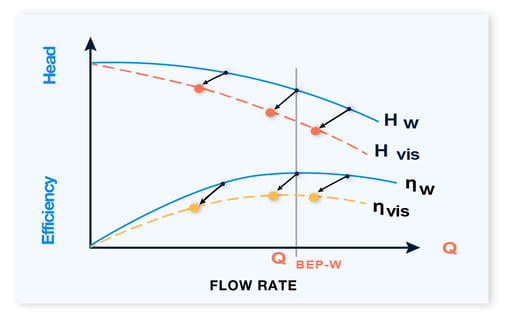10 Jan, 2023

Using FluidFlow in Evaluating Pump Performance | FluidFlow
FluidFlow enables engineers to make reliable assessments of centrifugal pump performance curves. The ability to create accurate hydraulic models and the application of the different software features help engineers investigate the following on a centrifugal pump:
- Operating Performance
- Impact of Affinity Laws
- Impact of fluid viscosity
- Impact of solid particles (for slurry streams)
The succeeding sections explain how FluidFlow can be used to evaluate each item above.
1. Operating performance assessment
A centrifugal pump’s satisfactory performance can be characterized by these parameters:
- Required pump output or volumetric flow rate is achieved.
- Proximity of its actual duty point relative to a specific pump model’s best efficiency point (BEP)
- Margin between the available and required Net positive suction head (NPSH)
- Likelihood of the pump to operate outside of the Vendor’s published curve
- Tendency of the pump to operate below its minimum allowable flow
- Ability of the pump to reach shutoff pressure due to minor increase in frictional losses or system resistance
To represent the impact of the items above, we can also utilize the Nelson – Barringer pump reliability curve (Figure 1). This curve depicts the most probable pump condition at a specific duty point on the curve:
Figure 1: Nelson - Barringer Pump Reliability Curve
Using FluidFlow, evaluating the potential for the pump to operate at any point on the curve can be made as can be observed in Figure 2. This is achieved through accurate representation of pipes, bends, fittings and other piping component or fluid system equipment; Along with a defined pump vendor characteristic curve for head, NPSHR and efficiency to develop a hydraulic model.
Figure 2: Sample Pump vs. System Curve Output
2. Assessing the impact of centrifugal pump affinity laws
Another good feature of FluidFlow is the ease of evaluating the impact of pump affinity laws on a particular pump. This type of evaluation is commonly applied in revamps or evaluating pumps for potential variable speed drive application, re-use, or re-servicing. The input field for centrifugal pumps allows ease in defining the effect of changing impeller diameter or operating speed as shown in Figure 3:

Figure 3 - Sample Centrifugal Pump Input Data
3. Evaluating impact of fluid viscosity
Typically, performance data provided by pump manufacturers are generally determined using water as the test fluid. Thus, using the pump on a more viscous fluid has a pronounced effect on its performance and can translate to a different pump performance curve when water is utilized as test fluid.
As shown in Figure 4, viscosity has an effect on the pump head and efficiency and in turn, affects the power requirement of the pump.

Figure 4 - Sample Viscosity Correction Plot for Centrifugal Pump
In FluidFlow, viscosity corrections for pumps can be made whenever applicable. The correlation applied to consider the effect of viscosity is based on ANSI / Hydraulic Institute (HI) Standard 967. This type of feature is configurable in the software as part of its Global Settings in the Calculation Options Menu (Figure 5).

Figure 5 - Viscosity Correction Configuration in FluidFlow
4. Investigating the impact of solids (For Slurry Streams)
When Non-Newtonian / Slurry Module is activated In FluidFlow, “Solids Derating” or the impact of slurry solids on pump performance can also be investigated using the software.
The presence of solid particles in a slurry can have a significant effect on a centrifugal pump that can cause derating. As solid concentration increases, head generated from the pump decreases due to greater frictional loss as slurry moves across the pump.
This feature can be enabled from the input tab of a centrifugal pump node (Figure 6) to utilize any of the following solid derating correlations:
- Fixed Reduction Ratio (Manual Input)
- R.P. King Method (Calculated)
- Hydraulic Institute Guideline 12.1 – 12.6 (Calculated)

Figure 6 - Solids De-rating Methods for FluidFlow
Evaluating pump performance helps ensure that the pump is operating efficiently and any potential issues are identified. FluidFlow can be used to evaluate different factors that may affect pump performance, including the effects of affinity laws, fluid viscosity, and solid particles. Additionally, using a more viscous fluid can impact the performance and power requirements of the pump.
In summary, FluidFlow is a useful tool for evaluating pump performance. Through an accurate hydraulic model and the use of different software features as described above, an engineer can:
- Identify whether a pump meets the desired operating throughput or total dynamic head near or at its best efficiency point (BEP).
- Evaluate the likelihood for a pump system to operate beyond mechanical limits set by pump manufacturers and engineering contractors.
- Through the application of pump affinity laws, determine the necessary modification for a pump impeller diameter or operating speed to meet a desired operating throughput or total dynamic head.
- Predict the actual performance of a pump when it will be repurposed to handle relatively viscous fluid or accurately predict the performance of a pump where the available pump curve is generated and referenced with water as the working liquid.
- For slurry systems, examine the decline in pump performance due to the presence of solids in the liquid stream.
Related Articles:
Centrifugal Pump Performance Curve Explained
The Application of Pump Affinity Laws to Predict Pump Performance
Operating Efficiency of Centrifugal Pumps
How to Check Centrifugal Pump Curve Fit Using FluidFlow
